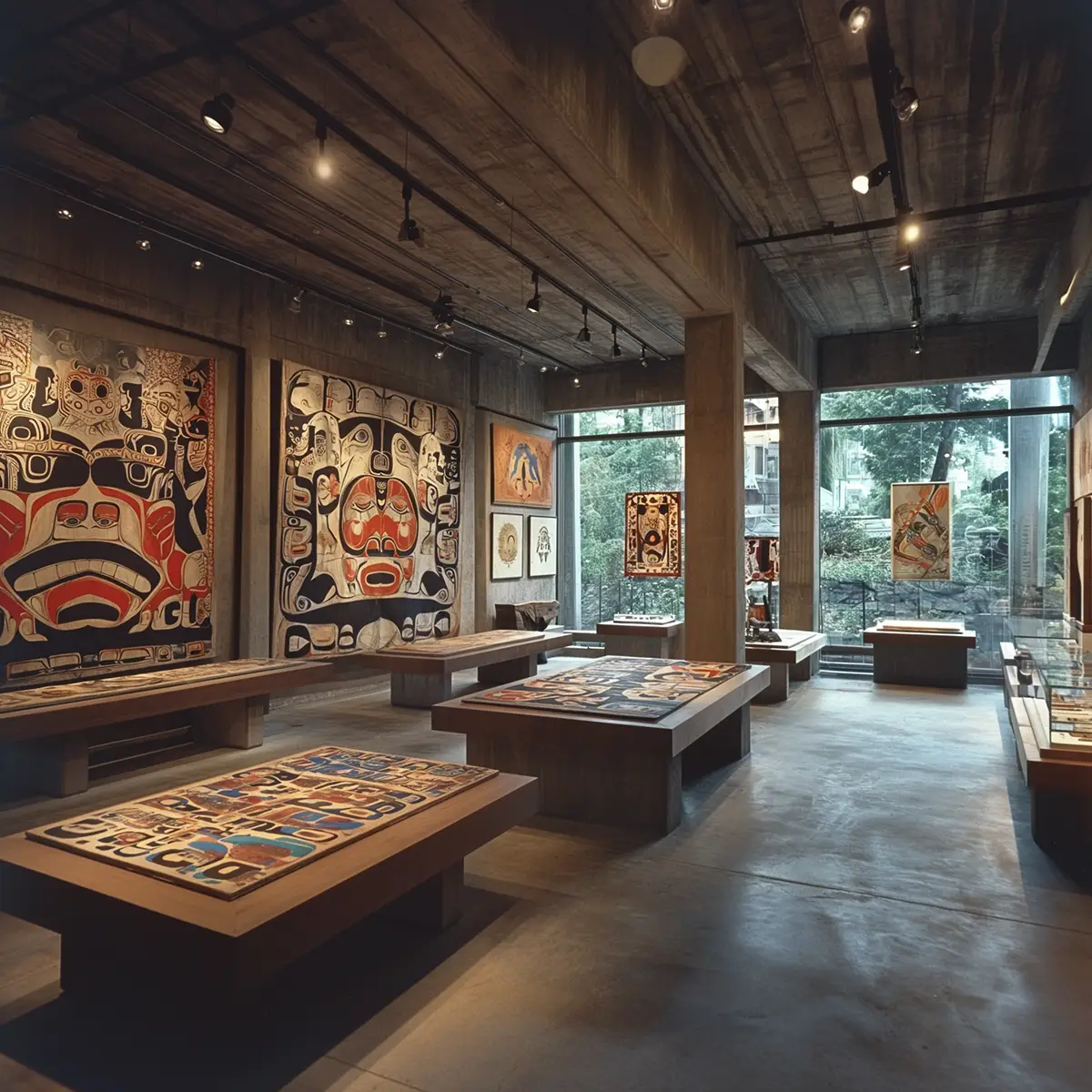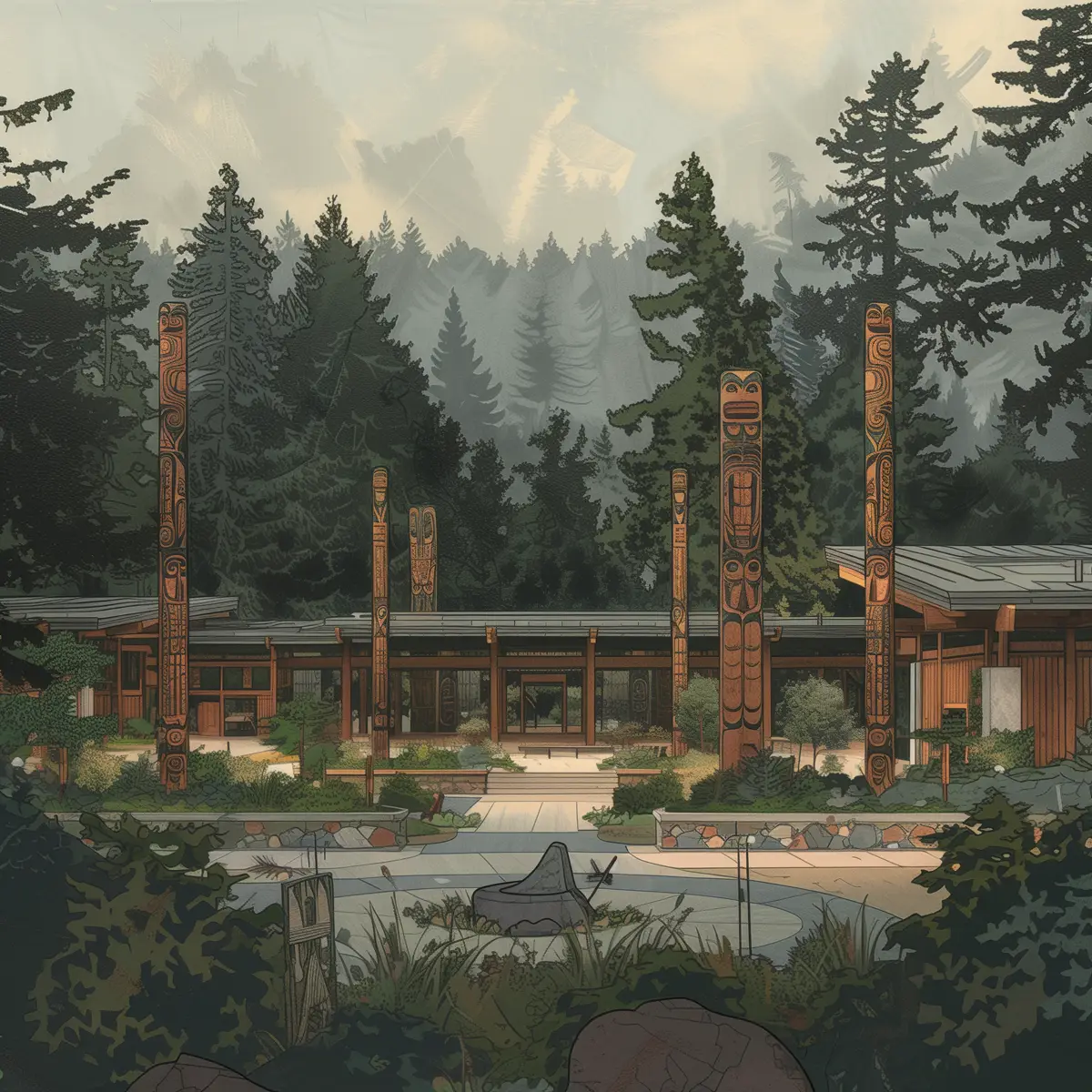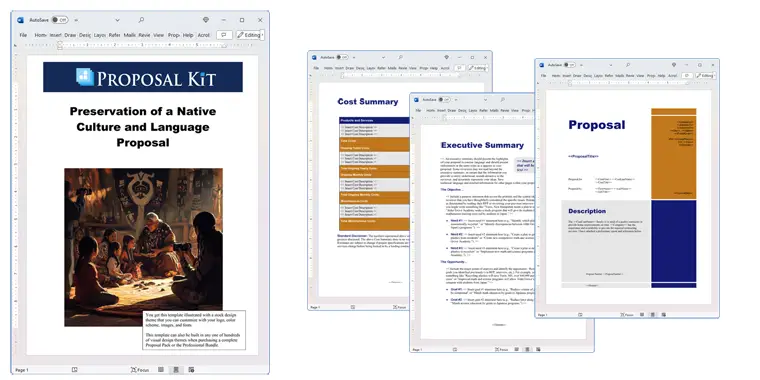How to write your Preservation of a Native Culture and Language Proposal
We include this 18 page layout with every Proposal Pack. If you want this template to have a different visual design theme than the one illustrated here, purchase any Proposal Pack design and create this template using the purchased design theme. This template is included in every Proposal Pack. If you get a Proposal Pack or the Professional, you can also make any variation of this template with different chapters to suit your needs.
We typically include more chapters in the templates than most people will need to give everyone more variety in the chapters they may need. You can trim down a long template by removing pages you do not need or combining multiple chapter topics into one page.
 DOWNLOADABLE, ONE-TIME COST, NO SUBSCRIPTION FEES
DOWNLOADABLE, ONE-TIME COST, NO SUBSCRIPTION FEESYou can also create countless variations of this document to suit your needs using the included library of 2200+ chapters if ordering a Proposal Pack or Professional.
 What Our Clients Say
What Our Clients SayYour Proposal Packs summarize in the best of fashion all the finest practices for businesses in their dealings with customers, mostly because they remain focused on the client’s solution, giving back to the customer the control over his project."
e-nstitute, Inc.
Related Article
Related Video
Related Templates
- Arts and Cultural Heritage Funding Project Proposal
- Indigenous Community Funding Project Proposal
- Translation and Transcription Writing Services Proposal
- Interpreter Services Proposal
- Museum Conservation Project Proposal
- Non profit Support Proposal
- Transcription Services Proposal and Contract
What's the best way to write your preservation of a native culture and language proposal?
When tasked with creating a proposal for the preservation of native culture and language, Proposal Kit offers a proven solution. Its template and software system is tailored to streamline your proposal's creation and integrate a line item quoting database for precise cost summaries, quotes, estimates, budgets, and other financial assessments.
If you need to write such a proposal, are you equipped with the tools to write and succeed in your mission to preserve vital cultural heritage? Proposal Kit has you covered, ensuring your proposal is professional and persuasive.
What Types of Projects Are Preservation of a Native Culture and Language Proposals Written For?
Preservation of native culture and language proposals are essential for initiatives aiming to sustain and rejuvenate cultural heritage. These proposals can be written for a variety of situations, including
- Development of cultural preservation educational programs
- Restoration of historic sites significant to a culture
- Documentation and archiving of linguistic materials
- Creation of cultural centers or museums
- Cultural festivals and public awareness campaigns
- Language revitalization courses and workshops
- Research projects on cultural practices
- Oral history recording projects
- Traditional arts revitalization programs
- Production of media in native languages
- Implementation of cultural competency training for organizations
- Development of native language dictionaries or encyclopedias
- Cultural exchange programs
- Environmental conservation projects linked to cultural practices
- Preservation of traditional culinary arts
- Development of mobile apps for language learning
- Youth engagement programs in cultural arts
- Grant writing for cultural preservation funding
- International collaboration for cultural heritage preservation
- Community-based participatory research in cultural studies
Chapters this template is built with
While there is no universal pre-written template that fits all situations, Proposal Kit's software allows customized proposal templates to be created that address the unique topics of each project. Here's how specific chapters from the Proposal Kit library can be tailored to write your proposal:
Cover Letter
The Cover Letter sets the stage for your proposal, emphasizing your commitment to cultural preservation and your desire to collaborate with the funding body or stakeholders. It should briefly introduce the main objectives of your project and convey your passion and dedication to preserving the native culture and language. Mention any previous successes or relevant experience to build credibility.
Introduction
Introduce the scope of your project, outlining the cultural significance and the urgent need for preservation efforts. This section should provide a snapshot of your project, its importance, and what you hope to achieve. It sets the stage for the rest of the proposal by giving the reader a clear understanding of the project's aims and context.
Problem Statement
Detail the specific cultural or linguistic challenges your project aims to address. This chapter should highlight the existing problems that threaten the native culture and language, such as declining speakers, loss of traditional knowledge, or lack of institutional support. Provide evidence and statistics to support your claims, making a case for the necessity of your project.
Take Action
Outline the actionable steps your project will take to achieve its goals, emphasizing how these actions will benefit the community. This section should include a detailed plan of activities, timelines, and milestones. Describe how each action step will contribute to the overall objectives of preserving and revitalizing the native culture and language.
Preservation
Discuss the methodologies and approaches for effective preservation of the culture or language. This might include digital archiving, developing educational programs, or creating dictionaries and language learning resources. Explain why these methods are suitable for your specific project and how they will ensure the long-term preservation of the cultural heritage.
Languages
Highlight the significance of revitalizing the target language(s) and its impact on the community. Describe how the project will help rejuvenate the language, increase the number of speakers, and integrate the language into everyday use. Include any planned partnerships with educational institutions or community organizations to support language learning and usage.
Extinction
Address the risks of inaction, detailing what might happen if the culture or language were to become extinct. This section should underscore the urgency of your project by explaining the potential cultural, social, and historical losses that could occur if preservation efforts are not undertaken. Use compelling narratives and testimonials from community members to illustrate cultural extinction's personal and communal impact.
Community
Explain how the community plays an important role in the problem and the solution, including community engagement strategies. Discuss how you will involve community members in the project, ensuring their voices and perspectives are included. Outline any community-driven initiatives and how they will foster a sense of ownership and pride in the preservation efforts.
Traditions
Elaborate on the specific traditions that your project aims to preserve or revive. This could include traditional arts, crafts, ceremonies, music, and storytelling practices. Explain how these traditions are integral to the cultural identity and how your project will support their continuity and transmission to future generations.
Culture
Discuss the broader cultural topics that your proposal aims to safeguard. This section should cover intangible cultural issues such as customs, values, social practices, and traditional governance systems. Highlight the interconnectedness of these topics with the language and how preserving one topic can benefit the overall cultural heritage.
Uses of Funds
Provide a detailed breakdown of how funds will be allocated to various project components. This chapter should include specific budget items such as personnel, materials, travel, equipment, and administrative costs. Justify each expense by explaining how it contributes to the success of the project and the achievement of its goals.
Funding Request
Clearly state your funding needs, including both immediate and long-term funding strategies. Specify the total amount of funding required and how it will support the project's activities. Include any matching funds or in-kind contributions from other sources to demonstrate additional support and commitment to the project.
Future Funding
Outline plans for sustaining funding beyond the project's life, ensuring long-term preservation efforts. Discuss potential funding sources, partnerships, and revenue-generating activities that can help maintain the project's momentum. Provide a sustainability plan that shows how the project's impacts will continue and grow over time.
Budget
Present a comprehensive budget for all project expenses, demonstrating fiscal responsibility. Include detailed line items and cost estimates, ensuring transparency and accountability. The budget should align with the activities and objectives outlined in the proposal, providing a clear financial roadmap for project implementation.
History
Reflect on the historical context of the cultural or linguistic topics being preserved, reinforcing the importance of your project. Provide a background on the community's heritage, significant historical events, and the evolution of the culture and language. This section should help the reader understand the depth of the cultural heritage and the importance of its preservation for future generations.
Use cases for this template
Harnessing Heritage for Community Engagement
The Challenge
Alice was concerned about her community's dwindling interest in a nearly forgotten artistic tradition. As the director of Heritage Harmony, she was acutely aware of these traditional arts' cultural and historical significance. Alice needed a comprehensive plan to attract funding and support, but she wasn't sure how to start. The challenge lay in creating a proposal that not only highlighted the importance of the project but also demonstrated its potential impact on the community.
The Solution
Alice discovered the Proposal Kit and used it to write her proposal. She found the Community and Traditions templates particularly useful, allowing her to seamlessly articulate the project's cultural significance and anticipated community benefits. These templates helped her frame the narrative that resonated with potential funders, emphasizing the cultural value and the practical community benefits of revitalizing the artistic tradition.
The Implementation
Alice outlined the project scope, objectives, and budget with Proposal Kit's comprehensive tools. She used the software to create a detailed plan that included a timeline of activities, a list of resources needed, and a cost breakdown. The proposal's clarity and professionalism made a case for the project's feasibility and importance. Alice also included testimonials and letters of support from community members to strengthen her proposal further.
The Outcome
Thanks to the well-written proposal, Alice secured funding from several cultural foundations. The funds enabled Heritage Harmony to organize community-based workshops that successfully revived interest in the traditional arts. These workshops taught new generations the skills and techniques and fostered a renewed sense of cultural pride and community cohesion. The project was a significant success and set the stage for further cultural preservation initiatives.
Reviving Language Through Technology
The Challenge
Bob, an employee at TechLingua, faced the challenge of developing a proposal for a mobile app designed to teach an endangered language. The task was complicated by a tight deadline; he had only a few weeks to submit a comprehensive proposal. The pressure was on to create a document that conveyed the project's goals, educational benefits, and user engagement strategies while aligning with the company's mission to support language preservation through innovative technology.
The Solution
Bob turned to Proposal Kit for help. He wrote a thorough and persuasive proposal using the Languages and Technology templates. These templates provided a structured format that helped him clearly articulate the app's objectives, the educational benefits it would provide, and the strategies for engaging users. The Proposal Kit's resources enabled Bob to present a vision of how the app could be critical in preserving the endangered language.
The Implementation
Bob used AI tools to refine the proposal's language and ensure it was perfectly aligned with TechLingua's mission. He prompted the AI to analyze the company's website and other resources to produce high-quality content that is seamlessly integrated with the proposal. The combination of Proposal Kit's structured templates and AI-generated content allowed Bob to create a professional document in record time. He included detailed sections on the app's development process, anticipated user demographics, and a comprehensive marketing plan.
The Outcome
The proposal's clarity and insight impressed TechLingua's board. They approved the project, recognizing its potential to impact language preservation significantly. Subsequently, the app was developed and launched, receiving widespread acclaim for its innovative approach and user-friendly design. It helped preserve the endangered language and inspired similar projects for other disappearing languages. The app's successful launch established TechLingua as a leader in language preservation technology.
Cultural Documentation for Future Generations
The Challenge
Carol, the director of the nonprofit organization Cultural Keepers, was tasked with documenting the oral histories of elders in her community. These stories were a living repository of cultural knowledge and practices at risk of being lost forever. Carol needed to write a Request for Proposal (RFP) to attract contractors with the expertise necessary for this sensitive and crucial task. The challenge was creating an RFP that was detailed enough to clarify the project goals and expectations while appealing to qualified contractors.
The Solution
Carol used the Proposal Kit to write the RFP, taking advantage of the History and Community templates. These templates helped her briefly outline the project's objectives, the historical significance of the oral histories, and the specific requirements for contractors. The Proposal Kit provided a structured approach that ensured all necessary details were included, from the project timeline to contractor selection criteria.
The Implementation
The RFP, created with Proposal Kit's guidance, was distributed to potential contractors with a clear and detailed project outline. Carol used the templates to specify the qualifications and experience needed, the project's scope, and the expected deliverables. She also included sections on the cultural sensitivity required for the project and methods for engaging with the community. The professional and comprehensive nature of the RFP attracted several highly qualified candidates.
The Outcome
Carol successfully contracted a team with extensive experience in cultural documentation. The team excelled in their work, conducting interviews with elders and capturing their stories with the respect and sensitivity they deserved. The result was a rich archival resource that preserved the oral histories for future generations. The project was celebrated within the community and beyond, ensuring that the cultural knowledge and practices of the elders would not be forgotten. The success of this initiative positioned Cultural Keepers as a key player in cultural preservation efforts, garnering further support and funding for similar projects.
Conclusions and Recommendations
With Proposal Kit, you gain access to specialized tools that simplify the writing process and enhance the quality and impact of your proposals. Whether you aim to secure funding, engage the community, or document invaluable cultural knowledge, the Proposal Kit provides you with the resources to achieve your goals and contribute to preserving precious cultural heritage.
Also Known As
This template may also be referred to in different ways or be used in more specialized situations, such as:
- Preservation of Indigenous Culture and Language Proposal
- Cultural Heritage Conservation Proposal
- Native Language Revitalization Bid
- Traditional Cultural Practices Project Proposal
- Endangered Cultural Elements Preservation Plan
- Heritage and Language Sustainability Proposal
- Cultural Revival and Maintenance Request
- Indigenous Traditions Reclamation Proposal
- Proposal for Native Cultural and Linguistic Preservation
- Cultural and Linguistic Heritage Protection Proposal
Abstract
 In recent years, the preservation of indigenous languages and cultures has become increasingly recognized as vital to maintaining the rich tapestry of cultural diversity worldwide. Indigenous communities face numerous challenges in keeping their native traditions and languages alive, calling for proactive steps in documenting, archiving, and revitalizing these invaluable cultural topics. This movement, supported by the United Nations and aligned with sustainable development goals, emphasizes the importance of linguistic diversity and indigenous knowledge for sustainable development.
In recent years, the preservation of indigenous languages and cultures has become increasingly recognized as vital to maintaining the rich tapestry of cultural diversity worldwide. Indigenous communities face numerous challenges in keeping their native traditions and languages alive, calling for proactive steps in documenting, archiving, and revitalizing these invaluable cultural topics. This movement, supported by the United Nations and aligned with sustainable development goals, emphasizes the importance of linguistic diversity and indigenous knowledge for sustainable development.
Recognizing this, proposals focusing on preserving indigenous languages serve as crucial instruments for fostering cultural preservation and revitalization efforts. Such proposals often encompass projects ranging from the development of educational programs, restoration of historic sites, and language revitalization workshops to the creation of cultural centers and the documentation of oral histories.
Successful proposals require meticulous planning and structure to communicate the urgency and necessity of preserving indigenous peoples' heritage. Proposal Kit provides tailored tools for creating comprehensive proposals with ease, offering features like complex document assembly, automated line-item quoting, and an extensive library of customizable content. These resources ensure that proposals are not only persuasive but also professionally presented, highlighting the significance of cultural heritage preservation.
 By engaging young people and local communities, these initiatives promote bilingualism and cultural pride, ensuring that traditional ways and native languages continue to thrive over the centuries. Through international cooperation and academic support, these preservation efforts contribute to a more diverse and culturally enriched society, inspiring governments and organizations to implement sustainable strategies for heritage and language conservation.
By engaging young people and local communities, these initiatives promote bilingualism and cultural pride, ensuring that traditional ways and native languages continue to thrive over the centuries. Through international cooperation and academic support, these preservation efforts contribute to a more diverse and culturally enriched society, inspiring governments and organizations to implement sustainable strategies for heritage and language conservation.
The task of preserving indigenous languages and cultures is not just about retaining words and traditions; it is about safeguarding the identity and survival of indigenous communities who have stewarded their lands and cultural practices for millennia. As native languages are increasingly threatened by globalization and climate change, there is a pressing need for initiatives that promote indigenous languages and facilitate their revitalization. The United Nations has declared an International Decade dedicated to these efforts, emphasizing the importance of addressing indigenous issues as part of a broader quest for equal access to cultural and linguistic resources.
Proposals aimed at cultural preservation serve as blueprints for action, guiding the work of indigenous groups, institutions, and principal investigators in their efforts to sustain these rich heritages. By implementing educational programs and creating language learning resources, these proposals offer practical solutions that benefit students and learners, enhancing their fluency and pronunciation in native languages. Through the establishment of community-driven projects, such initiatives ensure that language and culture remain at the forefront of societal development.
 The Proposal Kit plays a role in creating these proposals by providing tools that facilitate the precise translation of complex ideas into structured documents. Its extensive library of templates aids in addressing various topics of cultural preservation, from documenting spoken traditions to developing grammar resources. By simplifying the proposal-writing process, the Proposal Kit enables participants to focus on the core objectives of their projects, ensuring effective communication with stakeholders and potential funders.
The Proposal Kit plays a role in creating these proposals by providing tools that facilitate the precise translation of complex ideas into structured documents. Its extensive library of templates aids in addressing various topics of cultural preservation, from documenting spoken traditions to developing grammar resources. By simplifying the proposal-writing process, the Proposal Kit enables participants to focus on the core objectives of their projects, ensuring effective communication with stakeholders and potential funders.
In a world where linguistic diversity enriches the global environment, preserving native American languages and other indigenous languages is important for maintaining cultural balance. As universities and schools implement classes and workshops devoted to these languages, they provide learners with the opportunity to connect with their homelands and heritage. The positive effects extend beyond cultural preservation; they nurture a sense of belonging and pride within Indigenous communities. As these efforts continue, they exemplify how local and global initiatives can work together to create sustainable solutions that honor and preserve the ancient wisdom of the world's indigenous peoples.
In the ongoing efforts to preserve cultural heritage, the revitalization of indigenous languages has emerged as a powerful tool for reinforcing the identity and continuity of native American communities. These languages, which carry the collective wisdom and history of countless generations, face numerous threats from the dominance of other languages and the homogenizing forces of globalization. The United Nations has recognized the critical importance of this mission by designating an International Decade focused on the revitalization and preservation of indigenous languages. This initiative not only aims to protect these languages but also seeks to integrate them into modern-day communication and education systems across the globe.
 Indigenous institutions play a central role in these endeavors, serving as custodians of cultural knowledge and as advocates for the implementation of programs that bolster language learning and usage. The establishment of language courses, cultural workshops, and digital platforms provides practical examples of how these efforts can be implemented to achieve significant results. By harnessing technology and innovative teaching methods, these programs enhance the ability of learners to engage with native American languages, thereby fostering greater linguistic and cultural fluency.
Indigenous institutions play a central role in these endeavors, serving as custodians of cultural knowledge and as advocates for the implementation of programs that bolster language learning and usage. The establishment of language courses, cultural workshops, and digital platforms provides practical examples of how these efforts can be implemented to achieve significant results. By harnessing technology and innovative teaching methods, these programs enhance the ability of learners to engage with native American languages, thereby fostering greater linguistic and cultural fluency.
The Permanent Forum on Indigenous Issues acts as an important platform for discussing strategies and sharing insights on the global stage, highlighting how these initiatives positively affect communities worldwide. Through collaboration and shared experiences, Indigenous groups are empowered to create sustainable strategies that address the unique challenges they face. The impact of these efforts extends beyond the immediate community, as they contribute to a more diverse and resilient cultural landscape, enriching societies around the globe.
By embracing these initiatives, we not only preserve the linguistic and cultural wealth of indigenous peoples but also celebrate the diversity that strengthens our shared humanity. As we look to the future, continued commitment and collaboration in revitalizing indigenous languages will ensure that the rich tapestry of human culture remains vibrant and dynamic for generations to come.
Frequently Asked Questions
What are the important components of preserving a native culture and language proposal?
The important components of preserving a native culture and language proposal include a strong introduction, a clear problem statement, detailed sections on the proposed actions, cultural significance, and community involvement. You should incorporate topics highlighting the urgency of preserving the culture and language, such as a Problem Statement outlining the risk of extinction and a Community section detailing local involvement and benefits. A comprehensive budget and funding request, using templates like Budget and Uses of Funds, are also crucial to demonstrate the financial feasibility of your project.
How can Proposal Kit assist in writing a proposal to preserve native culture and language?
Proposal Kit provides an extensive library of customizable templates specifically designed to address various topics related to preserving a native culture and language proposal. The software includes detailed templates like Preservation, Languages, and Traditions, which help structure your proposal professionally and ensure all critical points are covered. Additionally, integrating a line item quoting database allows for precise financial planning, making your budget and funding requests clear and compelling to potential stakeholders.
What strategies can make preserving a native culture and language proposal more compelling?
To make preserving a native culture and language proposal more compelling, focus on the unique topics of the culture or language you aim to preserve. Use storytelling topics in sections like Introduction and History to paint a vivid picture of the cultural heritage's richness and the dire need for preservation. Effective proposals also emphasize community involvement and the long-term impact of the project. Using templates such as Community and Future Funding can help articulate how your project will benefit the present community and future generations.
What financial details should be included in preserving a native culture and language proposal?
A thorough financial breakdown is important in preserving a native culture and language proposal. This should include a detailed budget that itemizes all anticipated costs, from personnel to materials, and an explicit funding request. Templates like Budget and Uses of Funds in the Proposal Kit help you organize these details. It's also essential to include a Future Funding section to outline how you plan to sustain the project after initial funding, demonstrating your commitment to long-term cultural preservation.
What are common mistakes to avoid when writing a preservation of a native culture and language proposal?
One common mistake is failing to articulate the preservation effort's problem and urgency clearly. Ensure your Problem Statement outlines the threats to the culture and language and the consequences of inaction. Another pitfall is underestimating the importance of community involvement - make sure your Community section details how local stakeholders will be engaged and benefit. Additionally, vague or unrealistic budgets can undermine your proposal, so use the Budget and Uses of Funds templates to provide a clear and detailed financial plan. Lastly, ensure your proposal is well-organized and jargon-free, making it accessible to a broader audience.
20% Off Discount
![]() Add To Cart This Word Template
Add To Cart This Word Template
 Add To Cart Proposal Pack for Any Business
Add To Cart Proposal Pack for Any Business
 Add To Cart Proposal Kit Professional
Add To Cart Proposal Kit Professional
 4.7 stars, based on 849 reviews
4.7 stars, based on 849 reviewsProposal Kit chapters used in this template
Cover Letter, Title Page, Table of Contents, Introduction, Problem Statement, Extinction, History, Traditions, Preservation, Culture, Languages, Community, Funding Request, Uses of Funds, Future Funding, Budget, Take Action, Back Page
Line Item Automated Chapters
If you purchase a Proposal Pack or the Professional Bundle, these proposal pages are generated using an automated line-item database in the included Wizard software.
Funding Request, Future Funding, Budget Three Year
You use this proposal for
- General business proposal
- Non-technical proposal
- Project pitch proposal
- Non-government grant, non-profit, NGO proposal
- Spiritual, church, community proposal
- Foreign language, multilingual
How to create this template with Proposal Pack Wizard
You can create this document using any of the logo-designed Proposal Packs. Pick any Proposal Pack with a logo design theme you like best; they will all work equally well. The Proposal Pack for Any Business is the pack with no extra added logos or colors - designed to be used plain or for you to customize with your logos and graphics.
The Proposal Pack design theme you purchase will determine the visual look of this template. The screenshot above only shows the plain generic design theme.
We include a library of chapters to be assembled based on your needs. All proposals are different and have different needs and goals. We designed Proposal Pack so you can customize the documents to suit your needs.
You will best create this document using the Proposal Pack Wizard - Expert Edition software to select this template and build it in the Proposal Pack logo design theme of your choice along with any desired customizations (such as adding additional chapters, removing unneeded chapters, changing the order of chapters, and importing your company logo). This template outlines a proposal for the described situation. Each user is responsible for typing in the actual content of the provided pages with their information to complete the proposal. Suggestions in the abstract may include features in higher-end packages and are facilitated by the selection of chapter templates to support the narrative of each proposal, which help guide the user in filling in the details.
The Wizard software's AI Writer will write the content of the pages of the template based on details provided for your company, client, project, financial details and other writing instructions. This will provide a personalized version of the template completely written and ready to edit.
Once finished, the AI Writer's Word-to-PowerPoint converter can transform your proposal, business plan, or other business documents into a PowerPoint slideshow. Save time and effort by letting the AI analyze every chapter to condense its content into talking points, visually matching the document, and providing a consistent package of presentation material with the click of a button.
You create this template using the Wizard software with an entire Proposal Pack library and software. We include the Expert Edition of the software in the Proposal Kit Professional. Microsoft Word for Windows is required to use the customizing software. You can also edit Word document templates in other office software such as Word for Mac. We will assist Mac users in assembling complex templates for their first project if they do not have the required platform to run the Wizard software.
How to Build Templates Featured on Proposal Kit Website
Many people find the Proposal Kit website after searching for a specific proposal. Once you've purchased and installed the software, how do you build that template you found in the first place? This video shows you how to build any proposal you see on the Proposal Kit website.
 Ian Lauder has been helping businesses write their proposals and contracts for two decades. Ian is the owner and founder of Proposal Kit, one of the original sources of business proposal and contract software products started in 1997.
Ian Lauder has been helping businesses write their proposals and contracts for two decades. Ian is the owner and founder of Proposal Kit, one of the original sources of business proposal and contract software products started in 1997.By Ian Lauder
 Published by Proposal Kit, Inc.
Published by Proposal Kit, Inc.


 Cart
Cart
 Get 20% off ordering today:
Get 20% off ordering today: 


 Facebook
Facebook YouTube
YouTube Bluesky
Bluesky Search Site
Search Site